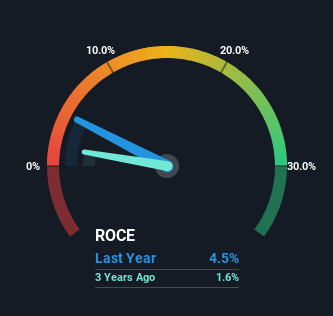Stock Analysis
- Hong Kong
- /
- Hospitality
- /
- SEHK:1655
There's Been No Shortage Of Growth Recently For Okura Holdings' (HKG:1655) Returns On Capital

What trends should we look for it we want to identify stocks that can multiply in value over the long term? Firstly, we'll want to see a proven return on capital employed (ROCE) that is increasing, and secondly, an expanding base of capital employed. If you see this, it typically means it's a company with a great business model and plenty of profitable reinvestment opportunities. Speaking of which, we noticed some great changes in Okura Holdings' (HKG:1655) returns on capital, so let's have a look.
What Is Return On Capital Employed (ROCE)?
For those who don't know, ROCE is a measure of a company's yearly pre-tax profit (its return), relative to the capital employed in the business. To calculate this metric for Okura Holdings, this is the formula:
Return on Capital Employed = Earnings Before Interest and Tax (EBIT) ÷ (Total Assets - Current Liabilities)
0.045 = JP¥690m ÷ (JP¥18b - JP¥3.1b) (Based on the trailing twelve months to June 2023).
So, Okura Holdings has an ROCE of 4.5%. Even though it's in line with the industry average of 4.7%, it's still a low return by itself.
View our latest analysis for Okura Holdings

Historical performance is a great place to start when researching a stock so above you can see the gauge for Okura Holdings' ROCE against it's prior returns. If you want to delve into the historical earnings, revenue and cash flow of Okura Holdings, check out these free graphs here.
What The Trend Of ROCE Can Tell Us
Okura Holdings has broken into the black (profitability) and we're sure it's a sight for sore eyes. The company now earns 4.5% on its capital, because five years ago it was incurring losses. Interestingly, the capital employed by the business has remained relatively flat, so these higher returns are either from prior investments paying off or increased efficiencies. So while we're happy that the business is more efficient, just keep in mind that could mean that going forward the business is lacking areas to invest internally for growth. So if you're looking for high growth, you'll want to see a business's capital employed also increasing.
The Bottom Line
As discussed above, Okura Holdings appears to be getting more proficient at generating returns since capital employed has remained flat but earnings (before interest and tax) are up. Astute investors may have an opportunity here because the stock has declined 38% in the last five years. That being the case, research into the company's current valuation metrics and future prospects seems fitting.
On a final note, we found 4 warning signs for Okura Holdings (1 makes us a bit uncomfortable) you should be aware of.
If you want to search for solid companies with great earnings, check out this free list of companies with good balance sheets and impressive returns on equity.
Valuation is complex, but we're helping make it simple.
Find out whether Okura Holdings is potentially over or undervalued by checking out our comprehensive analysis, which includes fair value estimates, risks and warnings, dividends, insider transactions and financial health.
View the Free AnalysisHave feedback on this article? Concerned about the content? Get in touch with us directly. Alternatively, email editorial-team (at) simplywallst.com.
This article by Simply Wall St is general in nature. We provide commentary based on historical data and analyst forecasts only using an unbiased methodology and our articles are not intended to be financial advice. It does not constitute a recommendation to buy or sell any stock, and does not take account of your objectives, or your financial situation. We aim to bring you long-term focused analysis driven by fundamental data. Note that our analysis may not factor in the latest price-sensitive company announcements or qualitative material. Simply Wall St has no position in any stocks mentioned.
About SEHK:1655
Okura Holdings
Okura Holdings Limited, an investment holding company, operates pachinko and pachislot halls in Japan.
Adequate balance sheet with acceptable track record.

